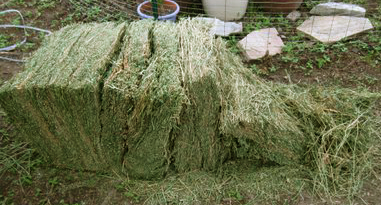|
Calliope Wholesale Hay & Feeds |
|
WHAT IS A FLAKE?
by Laurie McNally
Flakes are formed during a compression/release cycle that occurs in the baling process. First in the process of creating a bale a row of cut hay is picked up and place into the baling chamber, it is then compressed and cut on one side, pressure is released and the process repeated. Another portion of cut hay is picked up, put in the chamber, compressed and released in preparation for the next portion until the bale is full size. This process creates easy to separate sections called flakes.
But, are all flakes created equally? How large a flake is and how much hay is in it depends upon how much hay is fed into the bale chamber and the amount of pressure applied in compression. More hay in the chamber results in larger flakes, more compressions results in denser flakes. So, the answer is no, they are not equal, they can vary from bale to bale, and even within the same bale.
As there are no weight standards applied to a flake of hay, (just as there is no weight standard for a scoop of grain,) a flake cannot be reliably used as a portion control method. Generally a horse requires about 1% of his body weight per day of roughage in his diet. Using this rule of thumb a daily regimen for a 1,000 pound horse would be about 10 pounds of hay.
Therefore, in situations where it is necessary to control the exact amount of hay fed to your horse, the only reliable way to know for sure is to weigh it for yourself. |
|
|
|
|
|
Proudly serving all of Southern California, including the counties and areas of: Santa Barbara, Ventura, Inyo, Kern, Los Angeles, Orange, San Diego, Inland Empire, Riverside, San Bernardino and Imperial.
|
|
Call (760) 774-4212 Email FAX (760) 868-6162 Copyright 2011 Calliope Wholesale Hay and Feed Site designed and maintained by TKJConsult.com |
 Most horsepeople know that the term "flake" refers to a convenient, a thin,
easy to 'flake off' portion of a rectangular bale. While this measure is often taken for granted, here are
some helpful facts about how a flake is formed that you may need to know.
Most horsepeople know that the term "flake" refers to a convenient, a thin,
easy to 'flake off' portion of a rectangular bale. While this measure is often taken for granted, here are
some helpful facts about how a flake is formed that you may need to know.